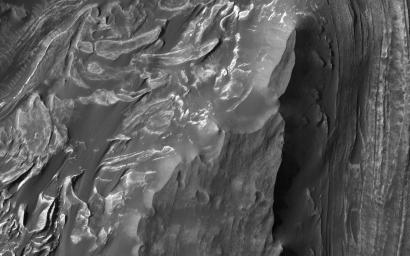
|
Mounds of Layered Material on the West Edge of Melas Chasma
- Click the image above for a larger view
- Full-Res JPEG (2880 x 1800) (662.3 kB)
- Full-Res TIFF (2880 x 1800) (5.2 MB)
Caption:

Map Projected Browse Image
Click on the image for larger version
Melas Chasma is the widest segment of the Valles Marineris canyon, and is an area where MRO has detected the presence of sulfates.
This image offers a view of an excellent contact between layered deposits that postdate the formation of Valles Marineris and possible deposits that predate the canyon's formation. The materials are near interior layered deposits that contain sulfates and likely have hydrated minerals. At high resolution, we can have more accurate mapping of the stratigraphic relationships and contacts. Enhanced color can help to differentiate between geologic units and for mapping of sulfates.
This caption is based on the original science rationale.
Background Info:
HiRISE is one of six instruments on NASA's Mars Reconnaissance Orbiter. The University of Arizona, Tucson, operates HiRISE, which was built by Ball Aerospace & Technologies Corp., Boulder, Colorado. NASA's Jet Propulsion Laboratory, a division of the California Institute of Technology in Pasadena, manages the Mars Reconnaissance Orbiter Project for NASA's Science Mission Directorate, Washington.
Cataloging Keywords:
| Name | Value | Additional Values |
|---|---|---|
| Target | Mars | |
| System | ||
| Target Type | Planet | |
| Mission | Mars Reconnaissance Orbiter (MRO) | Mariner |
| Instrument Host | Mars Reconnaissance Orbiter | |
| Host Type | Orbiter | Flyby Spacecraft |
| Instrument | High Resolution Imaging Science Experiment (HiRISE) | |
| Detector | ||
| Extra Keywords | Grayscale, Map | |
| Acquisition Date | ||
| Release Date | 2014-10-15 | |
| Date in Caption | ||
| Image Credit | NASA/JPL-Caltech/Univ. of Arizona | |
| Source | photojournal.jpl.nasa.gov/catalog/PIA18830 | |
| Identifier | PIA18830 | |
